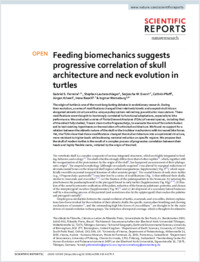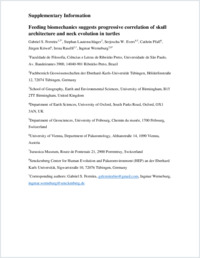Feeding biomechanics suggests progressive correlation of skull architecture and neck evolution in turtles
- Ferreira, Gabriel S. Universidade de São Paulo and Eberhard Karls Universität Tübingen
- Lautenschlager, Stephan University of Birmingham
- Evers, Serjoscha W. University of Oxford and University of Fribourg
- Pfaff, Cathrin University of Vienna
- Kriwet, Jürgen University of Vienna
- Raselli, Irena Jurassica Museum (Porrentruy) and University of Fribourg
- Werneburg, Ingmar Eberhard Karls Universität Tübingen
- 26.03.2020
Published in:
- Scientific Reports. - 2020, vol. 10, p. 5505
English
The origin of turtles is one of the most long-lasting debates in evolutionary research. During their evolution, a series of modifications changed their relatively kinetic and anapsid skull into an elongated akinetic structure with a unique pulley system redirecting jaw adductor musculature. These modifications were thought to be strongly correlated to functional adaptations, especially to bite performance. We conducted a series of Finite Element Analyses (FEAs) of several species, including that of the oldest fully shelled, Triassic stem-turtle Proganochelys, to evaluate the role of force distribution and to test existing hypotheses on the evolution of turtle skull architecture. We found no support for a relation between the akinetic nature of the skull or the trochlear mechanisms with increased bite forces. Yet, the FEAs show that those modifications changed the skull architecture into an optimized structure, more resistant to higher loads while allowing material reduction on specific regions. We propose that the skull of modern turtles is the result of a complex process of progressive correlation between their heads and highly flexible necks, initiated by the origin of the shell.
- Faculty
- Faculté des sciences et de médecine
- Department
- Département de Géosciences
- Language
-
- English
- Classification
- Palaeontology
- License
-
License undefined
- Identifiers
-
- RERO DOC 328361
- DOI 10.1038/s41598-020-62179-5
- Persistent URL
- https://folia.unifr.ch/unifr/documents/308641
Other files
Statistics
Document views: 221
File downloads:
- Fichier principal: 256
- Matériaux supplémentaires: 171

